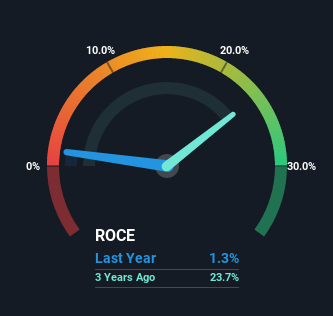- India
- /
- Energy Services
- /
- NSEI:SEAMECLTD
Returns On Capital Are Showing Encouraging Signs At Seamec (NSE:SEAMECLTD)

What are the early trends we should look for to identify a stock that could multiply in value over the long term? Firstly, we'd want to identify a growing return on capital employed (ROCE) and then alongside that, an ever-increasing base of capital employed. Basically this means that a company has profitable initiatives that it can continue to reinvest in, which is a trait of a compounding machine. With that in mind, we've noticed some promising trends at Seamec (NSE:SEAMECLTD) so let's look a bit deeper.
Return On Capital Employed (ROCE): What Is It?
For those who don't know, ROCE is a measure of a company's yearly pre-tax profit (its return), relative to the capital employed in the business. To calculate this metric for Seamec, this is the formula:
Return on Capital Employed = Earnings Before Interest and Tax (EBIT) ÷ (Total Assets - Current Liabilities)
0.013 = ₹115m ÷ (₹10b - ₹1.4b) (Based on the trailing twelve months to December 2022).
Therefore, Seamec has an ROCE of 1.3%. In absolute terms, that's a low return and it also under-performs the Energy Services industry average of 7.4%.
Check out our latest analysis for Seamec

While the past is not representative of the future, it can be helpful to know how a company has performed historically, which is why we have this chart above. If you're interested in investigating Seamec's past further, check out this free graph of past earnings, revenue and cash flow.
So How Is Seamec's ROCE Trending?
We're delighted to see that Seamec is reaping rewards from its investments and is now generating some pre-tax profits. The company was generating losses five years ago, but now it's earning 1.3% which is a sight for sore eyes. Not only that, but the company is utilizing 155% more capital than before, but that's to be expected from a company trying to break into profitability. We like this trend, because it tells us the company has profitable reinvestment opportunities available to it, and if it continues going forward that can lead to a multi-bagger performance.
In another part of our analysis, we noticed that the company's ratio of current liabilities to total assets decreased to 14%, which broadly means the business is relying less on its suppliers or short-term creditors to fund its operations. This tells us that Seamec has grown its returns without a reliance on increasing their current liabilities, which we're very happy with.
Our Take On Seamec's ROCE
To the delight of most shareholders, Seamec has now broken into profitability. And with the stock having performed exceptionally well over the last five years, these patterns are being accounted for by investors. Therefore, we think it would be worth your time to check if these trends are going to continue.
Seamec does have some risks, we noticed 3 warning signs (and 1 which is a bit concerning) we think you should know about.
While Seamec isn't earning the highest return, check out this free list of companies that are earning high returns on equity with solid balance sheets.
New: Manage All Your Stock Portfolios in One Place
We've created the ultimate portfolio companion for stock investors, and it's free.
• Connect an unlimited number of Portfolios and see your total in one currency
• Be alerted to new Warning Signs or Risks via email or mobile
• Track the Fair Value of your stocks
Have feedback on this article? Concerned about the content? Get in touch with us directly. Alternatively, email editorial-team (at) simplywallst.com.
This article by Simply Wall St is general in nature. We provide commentary based on historical data and analyst forecasts only using an unbiased methodology and our articles are not intended to be financial advice. It does not constitute a recommendation to buy or sell any stock, and does not take account of your objectives, or your financial situation. We aim to bring you long-term focused analysis driven by fundamental data. Note that our analysis may not factor in the latest price-sensitive company announcements or qualitative material. Simply Wall St has no position in any stocks mentioned.
About NSEI:SEAMECLTD
Seamec
Provides offshore oilfield and diving support vessel services in India and internationally.
Excellent balance sheet and fair value.
Market Insights
Community Narratives




